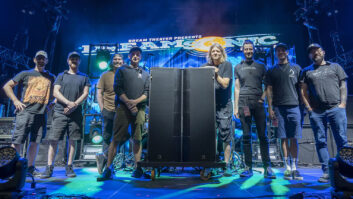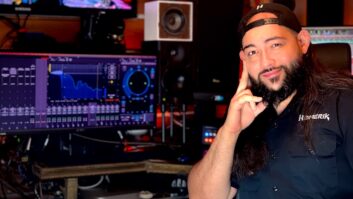Prolific pop and hip-hop craftspeople Nate ‘Danja’ Hills and Marcella Araica had long dreamed of a unique production space in the Miami music community. Having worked around the world in premier recording facilities for more than a decade each, Hills and Araica realized that their needs would be best met by teaming up with one of the industry’s most prolific and successful studio design teams, Walters-Storyk Design Group (WSDG).
“I’ve spent time in some pretty amazing studios around the country and the world—New York, LA, Vegas, London, Paris,” begins Araica. “Every studio I’ve ever worked in, I’ve taken mental notes of things I liked, things I didn’t like, and things I’d want to do on my own. When it came down to it, my partner Nate and I had these ideas for years—everything from design elements to colors to how it all made you feel from the moment you walked in the door.”
Araica became enamored by WSDG’s work while at Hit Factory in Miami. “John [Storyk] designed one of the best-sounding live rooms, as far as I was concerned—Hit Factory’s Studio E,” she continues. “Little by little, I found out more about the other projects he’d done; I loved Roc The Mic, Jay Z’s studio in New York, and the infamous Electric Lady. So I knew if I was ever going to build a studio, it would involve John.”
At Dream Asylum, Studio X (top) and Studio Y have very different vibes, but they have a few things in common: They each are outfitted with SSL 9000J consoles and share a 600-squarefoot live room. Built within a 4,000-square-foot former warehouse in South Florida, Dream Asylum is centered on a 600-square-foot live room with iso booths, shared by two distinct control rooms—Studio X for Hills and Studio Y for Araica, both with WSDG/Augspurger Monitoring Systems and near-identical SSL 9000J analog consoles, the latter of which were sourced via broker and refurbished pre-install by Warren Rhoades of Nashville’s Rhoades Audio. The 269-square-foot Studio X and 360-square-foot Studio Y are notably isolated via room-within-room build-outs. A third mix/writing studio, Studio Z, is also available for artists to work alone in while on site, featuring an SSL AWS Series mixer atop a stunning Lucite producer’s desk; a lounge/screening room and solarium are on-hand, too. Other notable custom details include a wooden rear-wall acoustic resonator and geometrical ceiling cloud in X, and “living room” vibe in Y with an oversized client couch set on a raised platform under a dropped ceiling.


While Dream Asylum is certainly collaboration-friendly, adjoining the work spaces so intimately was more about “extending the vibe,” explains Araica. “One thing I really wanted to get from the design was that while everyone is working, everyone would be involved; seeing each other across the live room in our respective control rooms is important. We build that kind of energy while being acoustically isolated so that we won’t interfere with the other’s projects. That’s the thing about most studios that I wanted to avoid: I’ve never felt good about being cut off, being isolated inside a building, so the idea of seeing constant energy moving around was something we really wanted. Also, the third control room is there if the artist wants to go into another space to create, but still, they aren’t cut off from us, either.”
“It’s always a problematic request, sharing a live room,” says WSDG project manager Romina Larregina. “During the schematic phase, the project started to grow. Each control room needed its own iso booth, too. We were ultimately able to accommodate for three control rooms, with Marcella and Nate looking into the same live room. We’ve been able to accomplish this in the past as well; we did a studio in San Francisco not too long ago with three independent control rooms needing to look into a common live room, and with proper isolation, it’s completely doable.”
There’s no denying that isolating the rooms at Dream Asylum from each other while needing full-range, high SPL-capable monitoring in each control room posed significant challenges. “From an acoustics point of view, the big challenge was that they are mixing what I’d consider ‘super loud,’” offers WSDG partner/director of International Relations Sergio Molho. “They work continuously while sharing the same live room. With two different programs of music, it was crucial that they wouldn’t bother each other; and it came down to isolation and mechanical vibration issues. In this warehouse, a typical building, there’s a lot of anomalies that posed challenges to isolation, so each studio is a completely isolated ‘room within a room’ on an isolated floor. In the end, it’s an amazingly quiet space in total, with the capability to contain extremely loud monitoring levels.”
Meanwhile, there was never a question regarding what consoles would become each control room’s centerpiece. As different as the control rooms are from one another, Dream Asylum’s dual SSLs are just about as similar as two “vintage” consoles can get. “The 9000J is almost embedded in my DNA,” offers Araica with a chuckle.
Gear, design and talents aside, Dream Asylum is a thriving production space with a lot of help from its locale; its just easy to please clients who come to the greater Miami area to work, confirms Araica. “It’s great because there’s so much culture right outside our doors—Little Havana on 8th Street, Miami Beach and the club world, or just up the road to Fort Lauderdale for a more laid-back experience. It’s a wide range of inspirations. I’ve worked in studios where I’ve been there for, like, 10 hours and just wanted to step out and do something different—and found nothing. In building this studio, we did think of everything, and we wanted to be close to everything. That’s what Miami offers.”
Dream Asylum
dreamasylumstudios.com







